
views
Doing the Prep Work for Your Essay

Develop a plan. Consider how much time you have to write the essay and develop a writing plan based on that. This will help you figure out how long to spend on each part of the essay writing process, and will also keep you on task. Be honest about your strengths and weaknesses when devising your plan. For example, if you are a good researcher but not great at editing, spend less time on the research section in favor of spending more time on the revising section. Make sure to schedule breaks for yourself to refresh your brain and recharge yourself. An example of a plan for a one-day essay writing project might look like this: 8:00 – 9:30 – Consider an essay question and argument for the topic. 9:30 – 9:45 – Take a short break. 10:00 – 12:00 – Conduct research. 12:00 – 13:00 – Outline the essay. 13:00 – 14:00 – Take a lunch break. 14:00 – 19:00 – Write your essay. 19:00 – 20:00 – Take a dinner break. 20:00 – 22:30 – Revise and copy edit your essay. 22:30 – 23:00 – Print and prepare your essay submission.

Consider the essay question. You may know the topic of an essay when your teacher assigns it to you, but even if you don’t, first consider the question and different ways you could make arguments about the topic. Doing this preliminary brainstorming will not only direct you towards the appropriate research, it will help the writing process go more quickly. Make sure you understand what the question is asking for! If you provide a summary when the essay prompt asked you to “analyze,” you’re unlikely to do very well. If you don’t have an essay topic, choose a subject that interests you and consider the essay question afterward. You are more likely to write a good essay on a topic that you’re interested in.

Develop your argument or thesis statement. Your argument or thesis statement is the point you’re making in the essay through evidence and analysis. Develop your argument to help direct your research and make the writing process go more quickly. If you don’t have much experience with your topic, it might be difficult to develop an argument. You can still consider your argument and then use your research to support or refute the claims you want to make. A good exercise to help you quickly figure out your essay question and argument is to write “I am studying (choose a topic) because I want to know (what do you want to know) in order to show (this is where your argument goes).” For example, “I am studying the medieval witch trials because I want to know how lawyers employed evidence in their cases in order to show that the trial process influenced modern medical techniques and legal practices.” Consider counter-arguments in order to strengthen your essay.

Research your essay topic. You’ll need to strategically research your topic to find the evidence that will help you construct your argument and form the body of your essay. There are many different types of sources you can use for research, from online journals and newspaper archives to primary sources at the library. Since you don’t have a lot of time to write, focus on one or two places where you can do research. For example, the library and internet offer many different options for sources. Just make sure that you use reliable sources, such as peer-reviewed journals, government and university websites, and newspapers and magazines written by professionals. Don’t use personal blogs, obviously biased sources, or sources that don’t have professional credentials. You can draw upon information you know to speed up the research process. Simply find a (reliable!) source to support it and include it in your sources. Doing preliminary research online can point you to sources in a library such as books and journal articles. It can also point you in the direction of web sources including newspaper article archives or other research on your topic. If you're reading books, "gut" the book to get through it quickly and move on to other sources. To "gut" a book, skim the introduction and conclusion to find the main arguments, and then pick a few details from the body of the book to use as evidence. Take notes on your research sources. These will show that you’ve legitimately researched the topic while giving credit to the person who forwarded the idea. This is especially important if you plan to use direct quotes and will also help you add footnotes and bibliographic information to your essay without having to look them up in the sources.
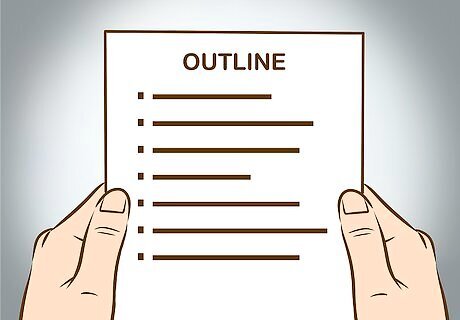
Write an outline of your essay. Construct an outline of your essay to guide you through the writing process. By structuring it in the same form as your essay and adding evidence, you will simplify and expedite the writing process. You’ll also be able to identify any areas that need better development. Structure your outline as you will your essay, with an introduction, a body, and a conclusion. The more detail you put into your outline, the easier and more quickly you can write the essay. For example, instead of just writing a basic paragraph about the body, flesh it out into bullet points or sentences that presents argument and supporting evidence.
Writing an Untimed Essay

Set a fixed amount of time to write. Allotting a specific amount of time can help you write more quickly because it puts pressure on you to perform. Set up your working environment so that you don't have any distractions during this time and allow yourself to write freely. Nothing will keep you from finishing an essay on time like goofing off online or ending up watching eight straight hours of Cartoon Network. Turn the TV off, switch your phone to silent, and exit out of Facebook and other social media/chat sites. Make sure you have all your material nearby when you start to write. Getting up to fetch a book or a piece of paper or a snack will eat into your precious time.
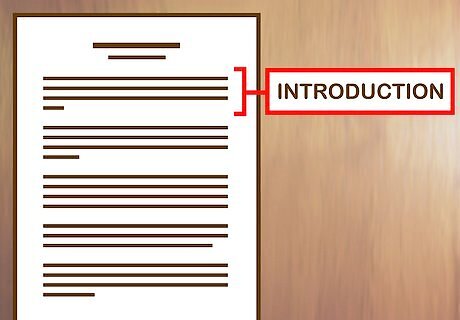
Write a catchy introduction. The introduction does exactly what the word says: it explains to the reader what you’re going to say in the essay. The introduction should grab, or hook, your reader’s attention and entice them to read the rest of the essay. The most important part of your introduction is your argument or thesis statement. This tells the reader the point your trying to make in the essay. Write a “hook” that will grab the reader’s attention to start, then introduce the argument with a few relevant facts woven into the narrative. End by stating how you will demonstrate your points. An example of a hook could be, “People say Napoleon had a complex because of his size, but he was actually an average height for the time in which he lived.” It's sometimes helpful to write the introduction after you have written the body so you know how to introduce the topic and your arguments best. A good rule of thumb is to not have the introduction be more the 10% of your essay. Thus, for a five page essay, you shouldn’t write more than one paragraph.
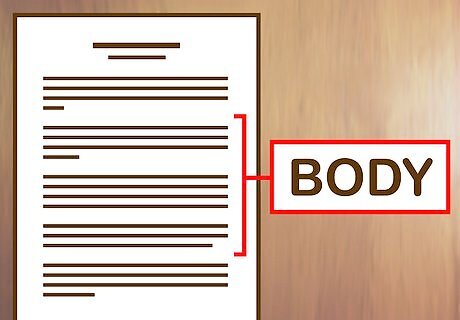
Write the body of the essay. The body of your essay will contain the substantive points that support your thesis statement or argument. Analyzing two to three main points will strengthen your argument and add more words to your overall total. Pick two to three main points to help make your argument or thesis statement. Any fewer and you won’t have enough evidence for your argument and any more may make you not explore each point thoroughly enough. Keep your evidence to support the main points concise. Going off on explanatory tangents will cost you precious time. Support your main points with the evidence compiled during your research. Make sure to explain how the evidence supports your claims! If haven’t reached your word limit, pick a main point and conduct more research on it to expand on your point.

Write as clearly as possible. If you’re writing quickly, it will simplify the process to write easy sentences without difficult grammatical structures. This also makes it less likely that you’ll improperly use convoluted jargon. Avoid "fat" language when you write. Text that includes long prepositional phrases, passive verbs, and paragraphs that don't further your argument waste time that you could spend writing or revising your essay.
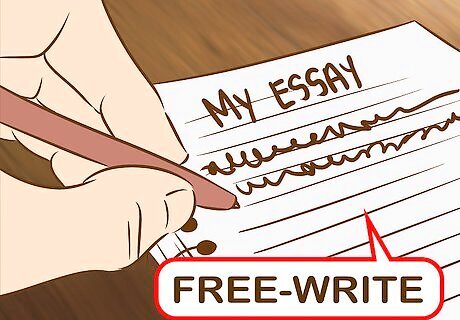
Allow yourself to “free-write” to optimize your time. It’s easier to draft text and subsequently edit than it is to work with nothing. By just allowing yourself to write freely, you’re assured to have some text that you have something to shape during the revision process. Free-writing can also help you overcome writer’s block that results from not knowing how to say something. If you’re struggling with getting the wording of an idea just right, write it as well as you can and come back to it later.

Write the essay conclusion. Like the introduction, the conclusion does exactly what the word implies: it brings your essay to an end. It provides a summary of your basic argument and should leave the reader with a strong impression of your work. The essay conclusion should also be relatively short. Aim for the conclusion to be 5-10% of your essay’s total length. Aim to do more in your conclusion than just restate your thesis and the evidence you used. You could acknowledge the limitations of your argument, suggest a direction for future research, or expand the relevance of your topic to a wider field. Just as you drew in reader with good introduction, end your conclusion with a sentence that make a lasting impression on your reader.

Revise and proofread your essay. No essay is good when it contains mistakes. Revising and proofreading your will ensure that the essay you composed quickly doesn’t have any glaring errors. It’s also important to revise and proofread so that you leave a good impression on your readers. Re-read the entire essay. Make sure that you are still arguing the same thing at the end of the essay that you are at the beginning. If not, go back and adjust your thesis. Make sure that your paragraphs build on one another and don’t feel haphazard. You can use transitions and strong topic sentences to help you draw connections between your paragraphs. Spelling and grammar are the easiest mistakes to revise, but they cost you a lot of reader goodwill if you don’t fix them.
Writing a Timed Essay

Plan your work. Even though you may only have a few hours to write this essay, taking a few moments at the beginning to develop a quick plan will help you perform at your best. Read the prompt carefully! If the question asks you to take a position, take one. If it asks you to evaluate the events that led to the downfall of Rome, don’t just give a summary of Roman history. Jot down an idea map. You probably won’t have time to make a formal outline. However, having an idea of the main points that you want to touch on and how they relate will help you structure the essay. If you can’t figure out how to connect your main points, that’s a sign you need to think a little bit more before you start writing. Figure out your argument. Once you’ve noted down some main points, figure out what you want to say about them. Even timed essays need a unified argument or thesis.
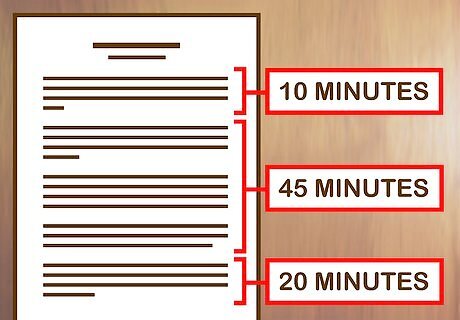
Time your writing strategically. If you must answer more than one essay question during a time period, make sure that you leave yourself enough time to write all of them. It’s also a good idea to check the grade values for your essay questions, too. For example, you wouldn’t want to spend the same amount of time and effort on a 3-paragraph essay question worth 20% as you would a 2-page essay question worth 60%. If you see a question that you feel will be more difficult for you, it could be a good idea to tackle it first. This will get the hard stuff out of the way while you’re still fresh.

Cut the fluff. All too often, students will write their way into their ideas after spending a whole paragraph on meaningless generalizations. Particularly in timed essays, it is very important to get directly to your main argument and providing evidence for it. Spending too much time on the introduction can leave you with less time to write later. If you notice that your introductory paragraph starts with something broad or hugely general, such as “Throughout the history of time, humans have been fascinated by science,” cut it. Don’t put anything in a timed essay that doesn’t support your point. If you are talking about the importance of religious belief in modern society, don’t dilute your point by also referencing socialism, Hollywood, and banana farming.

Explain connections between evidence and claims. A common issue with essays, especially those produced under pressure, is that student writers often present evidence without explaining how it links back to their claims. Make sure that you follow the “C-E-E” (Claim-Evidence-Explanation) formula for each paragraph: Claim. This is the main argument of the paragraph. It is probably located in your topic sentence. Evidence. This is the supporting detail that proves your claim. Explanation. This connects the evidence back to your claim and explains why the evidence proves what you say it does. If anything in your paragraph doesn’t fit one of these three elements, it’s a good sign you don’t need it in the paragraph.

Leave time to revise. Even in timed situations, you will want to leave some time to revise. This means more than cleaning up spelling and other minor errors. Read back through your whole essay. Does the essay actually demonstrate and support what your thesis says is the main argument? It’s not uncommon for ideas to evolve as you write. If this has happened, tweak your thesis accordingly. Do the paragraphs flow smoothly from one to the next? Timed essays don’t have the same standards that regular essays do, but your reader should still be able to follow your argument in a logical progression without feeling yanked around or lost. Do you offer a conclusion that sums up your argument? Don’t leave the essay hanging without a conclusion. Even if it’s very brief, a conclusion will help your essay feel complete.



















Comments
0 comment